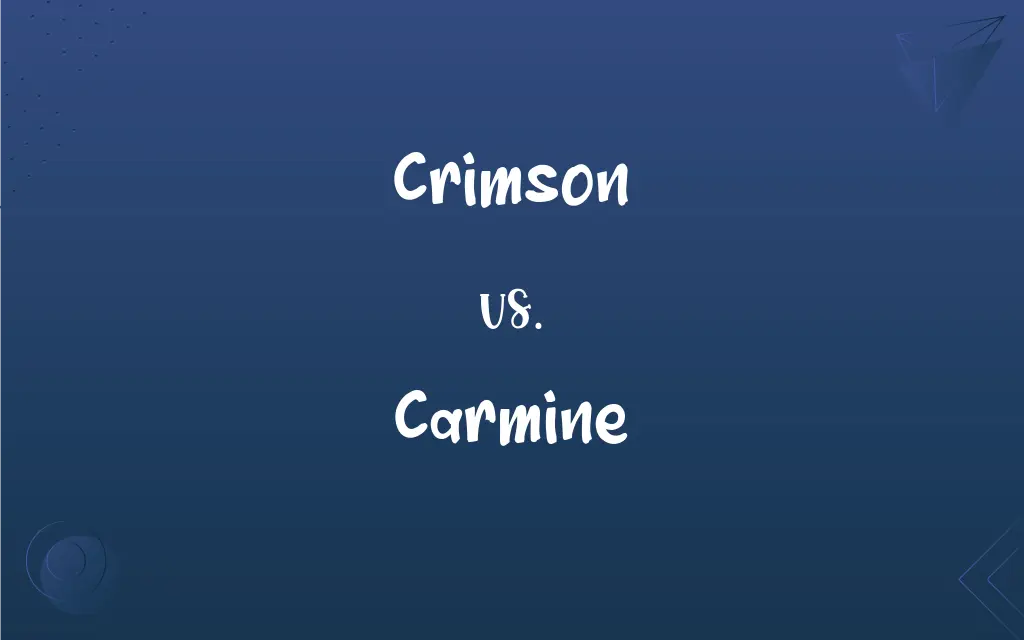Crimson vs. Carmine: What's the Difference?
Edited by Aimie Carlson || By Janet White || Updated on October 12, 2023
Crimson is a deep red color leaning towards blue, while Carmine is a vivid red color derived from cochineal insects.

Key Differences
Crimson often denotes a deep, purplish-red hue that tends to be slightly bluish. Carmine, in its essence, is a bright red color which originates from a specific dye derived from cochineal insects.
Crimson has been used in the English language as both an adjective and a noun to describe colors reminiscent of twilight or blood. Carmine, apart from its general use as a color descriptor, has also been employed in contexts like cosmetics, art, and dyeing due to its origin.
Both colors, Crimson and Carmine, hold significant historical and cultural contexts. While crimson has associations with power, nobility, and wealth in various cultures, carmine has its roots in Central and South American civilizations, being used as a dye for fabrics and as a pigment in paints.
Crimson can sometimes be interchangeably used with other deep red shades like ruby or garnet, but it holds its uniqueness in its slightly bluish undertone. Carmine, on the other hand, is quite distinct due to its vividness and the specific source from which it is derived.
When used in art or design, Crimson might evoke feelings of passion, urgency, or depth. Carmine, with its bright and intense shade, can bring out reactions of vitality, energy, and attention.
ADVERTISEMENT
Comparison Chart
Definition
A deep purplish-red color.
A bright red dye or pigment derived from the cochineal insect.
Usage in Sentence
"The crimson sunset was a sight to behold."
"The lipstick contained carmine as one of its ingredients."
Origins
English language as a descriptor of deep reds.
Derived from cochineal insects, historically used in Central and South America.
Associated Feelings
Passion, depth, urgency.
Vitality, energy, attention.
Usage
More generic; used as an adjective/noun for deep purplish-red hues.
Specific; often related to its source or its use in dyes and pigments.
ADVERTISEMENT
Crimson and Carmine Definitions
Crimson
A deep, purplish-red hue.
The sky was a stunning shade of crimson that evening.
Carmine
A vivid red dye or pigment derived from the cochineal insect.
Artists often favored carmine for its rich and lasting color.
Crimson
A shade of red with a slight bluish undertone.
She wore a crimson dress that contrasted beautifully with her pale skin.
Carmine
A color often associated with luxury and opulence due to its source.
The carmine drapes added a touch of luxury to the room.
Crimson
A color resembling that of blood.
The fabric had a rich crimson tint to it.
Carmine
A bright red hue, particularly used in cosmetics, art, and dyeing.
The lipstick had a carmine shade that looked stunning on her.
Crimson
A color reminiscent of twilight or dusk.
The crimson horizon was a signal that the day was ending.
Carmine
A shade reflecting vitality, energy, and attention.
The carmine banner was hard to miss in the crowd.
Crimson
A color often associated with passion, depth, or urgency.
His crimson tie made a bold statement.
Carmine
A color rooted in Central and South American cultures.
Historically, carmine was prized for its brilliant color and rarity.
Crimson
A deep to vivid purplish red to vivid red.
Carmine
A strong to vivid red.
Crimson
To make or become deeply or vividly red.
Carmine
A crimson pigment derived from cochineal.
Crimson
A deep, slightly bluish red.
Carmine
Strong to vivid red.
Crimson
Having a deep red colour.
Carmine
A purplish-red pigment, made from dye obtained from the cochineal beetle; carminic acid or any of its derivatives.
Crimson
Immodest. en
Carmine
A purplish-red colour, resembling that pigment.
Crimson
(intransitive) To become crimson or deep red; to blush.
Carmine
Of the purplish red colour shade carmine.
Crimson
(transitive) To dye with crimson or deep red; to redden.
Carmine
A rich red or crimson color with a shade of purple.
Crimson
A deep red color tinged with blue; also, red color in general.
Though your sins be as scarlet, they shall be as white as snow; though they be red like crimson, they shall be as wool.
A maid yet rosed over with the virgin crimson of modesty.
Carmine
A beautiful pigment, or a lake, of this color, prepared from cochineal, and used in miniature painting.
Crimson
Of a deep red color tinged with blue; deep red.
The blushing poppy with a crimson hue.
Carmine
The essential coloring principle of cochineal, extracted as a purple-red amorphous mass. It is a glucoside and possesses acid properties; - hence called also carminic acid.
Crimson
To dye with crimson or deep red; to redden.
Signed in thy spoil and crimsoned in thy lethe.
Carmine
A variable color averaging a vivid red
Crimson
To become crimson; to blush.
Ancient towers . . . beginning to crimson with the radiant luster of a cloudless July morning.
Carmine
Color carmine
Crimson
A deep and vivid red
Carmine
Having any of numerous bright or strong colors reminiscent of the color of blood or cherries or tomatoes or rubies
Crimson
Turn red, as if in embarrassment or shame;
The girl blushed when a young man whistled as she walked by
Crimson
Having any of numerous bright or strong colors reminiscent of the color of blood or cherries or tomatoes or rubies
Crimson
Characterized by violence or bloodshed;
Writes of crimson deeds and barbaric days
Fann'd by Conquest's crimson wing
Convulsed with red rage
Crimson
(especially of the face) reddened or suffused with or as if with blood from emotion or exertion;
Crimson with fury
Turned red from exertion
With puffy reddened eyes
Red-faced and violent
Flushed (or crimson) with embarrassment
FAQs
Does "crimson" have historical or cultural significance?
Yes, "crimson" has been associated with power, nobility, and wealth in various cultures.
Can "crimson" and "carmine" be used interchangeably?
While both refer to shades of red, they are distinct, with "crimson" being deeper and "carmine" being brighter and derived from a specific source.
Are there variations within the "crimson" color?
Yes, like all colors, there can be lighter or darker shades of "crimson."
Is "crimson" always a deep shade of red?
Typically, "crimson" denotes a deep, purplish-red hue, often with a bluish undertone.
Is "carmine" naturally derived?
Yes, traditional carmine is derived from cochineal insects.
Are there synthetic versions of "carmine" in cosmetics?
Yes, due to ethical and allergic concerns, synthetic alternatives to carmine are sometimes used in cosmetics.
Which is brighter, "crimson" or "carmine"?
"Carmine" is generally brighter and more vivid than "crimson."
Why is "carmine" prized in art?
"Carmine" is favored for its rich, lasting color and its historical significance.
Is "carmine" a vegan pigment?
No, traditional carmine is derived from insects, making it non-vegan.
Can "crimson" be found in nature?
Yes, "crimson" hues can be found in nature, especially in sunsets, flowers, and some fruits.
Is "crimson" related to any specific natural source?
Not specifically, "crimson" is a general descriptor for a deep purplish-red hue.
Is "carmine" safe to eat?
Carmine has been used as a food coloring, but some people might be allergic. Always check with food agencies or doctors.
Does "crimson" have any literary significance?
In literature, "crimson" often symbolizes passion, danger, or desire.
How is "carmine" extracted from cochineal insects?
The insects are dried, crushed, and then boiled to produce the carmine dye.
Is "carmine" a sustainable source of dye?
While it's natural, concerns about ethical treatment of insects and scalability make its sustainability debatable.
About Author
Written by
Janet WhiteJanet White has been an esteemed writer and blogger for Difference Wiki. Holding a Master's degree in Science and Medical Journalism from the prestigious Boston University, she has consistently demonstrated her expertise and passion for her field. When she's not immersed in her work, Janet relishes her time exercising, delving into a good book, and cherishing moments with friends and family.
Edited by
Aimie CarlsonAimie Carlson, holding a master's degree in English literature, is a fervent English language enthusiast. She lends her writing talents to Difference Wiki, a prominent website that specializes in comparisons, offering readers insightful analyses that both captivate and inform.































































